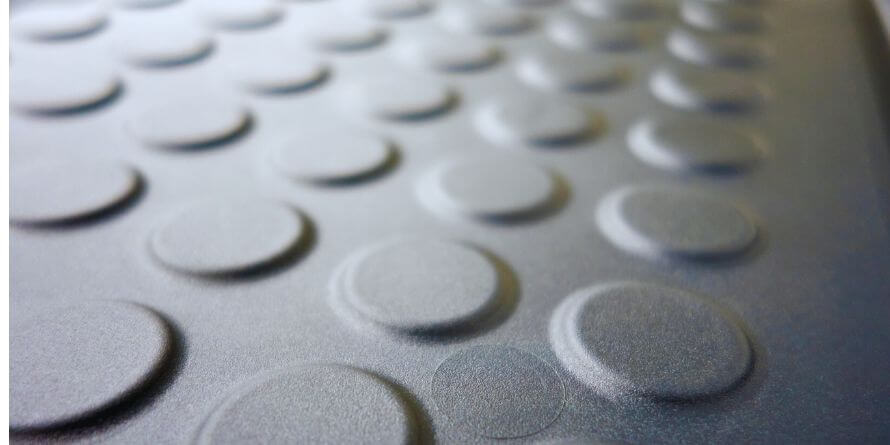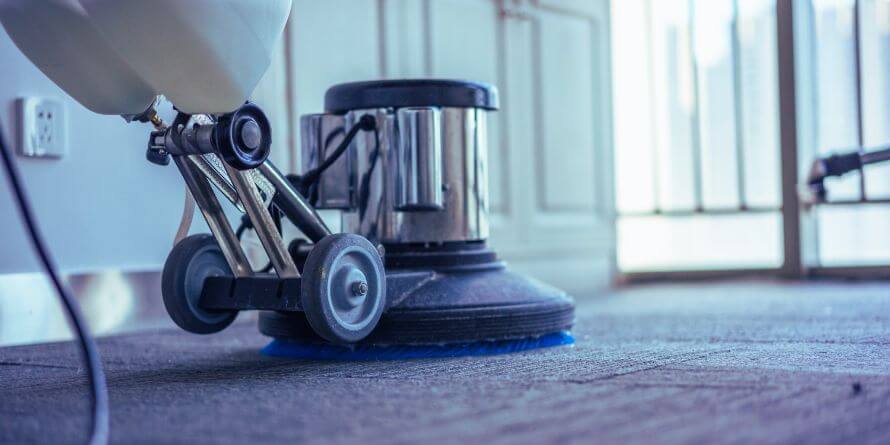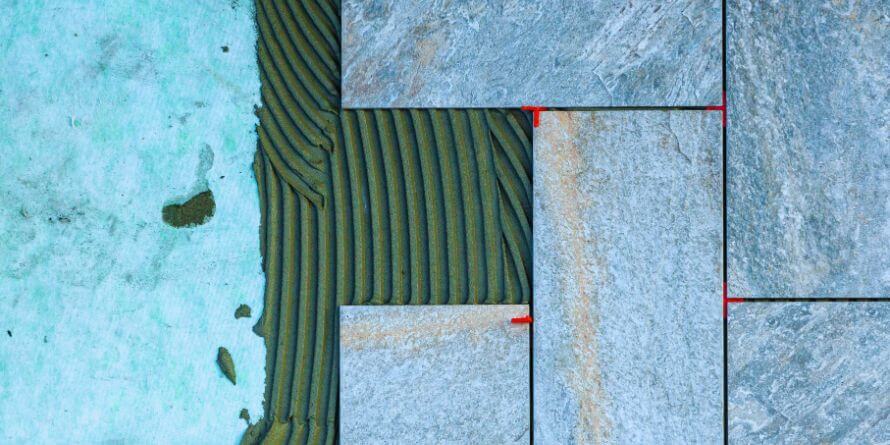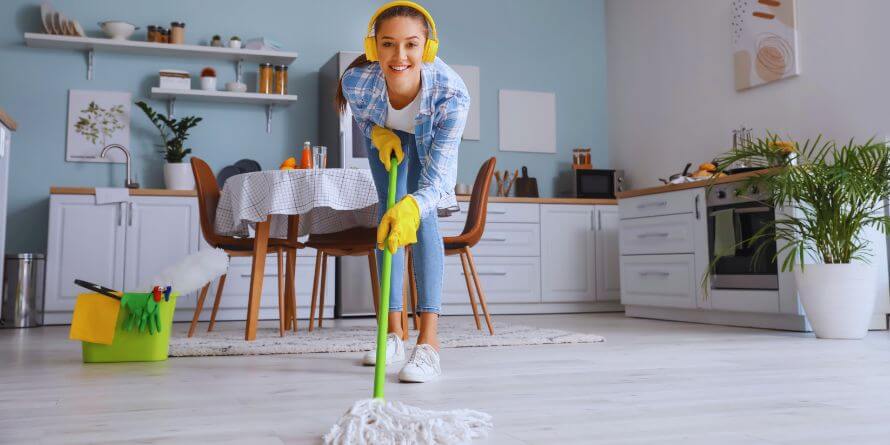Every home organizer desires to ensure slip resistance when selecting the kitchen floor. The kitchen is the busiest part of the house, but it also presents slippery risks due to falling oil and water during cooking tasks.
Therefore, the selection of non-slippery tiles provides safety and boosts the kitchen’s beautiful appearance. The most intriguing question during floor making is, what is the best non-slip tile?
Proper tile selection makes the kitchen secure for users with mobility issues and the elderly. They can safely perform their cooking duties without facing slippery incidents. There are several considerations to consider when buying the floor tiles for the kitchen.
The slip resistance rating is the first thing to notice before buying kitchen floor tiles. Tile with a high COF indicates the best resistance against slipping after getting wet.
Furthermore, tiles with textured surfaces are safer to walk on than those with a smooth appearance.
Best Tile For Kitchen Floor Non-Slip;
Durability and functionality checking are essential to ensure the selected material can withstand heavy foot traffic. As the kitchen floor receives more spills and water splashes, the floor must have water resistance to stay safe for a long time.
With all safety features, the floor tiles must have an aesthetic appearance that complements the other interior of the kitchen. This guide deals with detailed knowledge about the shop’s best tile for kitchen floor non-slip.

Types of Non-Slip Tiles
Several options are available in the market for a non-slip floor material. Each one is different in care methods, durability, and appearance.
A home organizer must know about them to make the proper selection according to the floor’s needs. In order to be safe, you can use some of the non-toxic floor cleaners.
Ceramic Tiles
After considering some essential features, selecting Ceramic’s best tile for a kitchen floor with non-slip is possible. For example, ceramic is known for its strong ability to bear wear and tear.
The material can maintain its formation in high-traffic situations. Its textured finish makes it safe against slipping incidents. Ceramic is also easy to clean because it prevents stubborn stains from developing.
Durability against damage and availability in a wide range of patterns and colors provide a complete package for installing the best non-slip tiles in the kitchen.
Porcelain Tiles
The non-porous manufacturing of porcelain floor tiles for kitchens provides maximum safety and security against hard grease. Users can confidently install these tiles in the kitchen.
Their high-density texture prevents slipping on wet floors. The best porcelain tiles for the kitchen floor are those that come with a tight binding of porcelain particles, making them the most rigid material to install on a kitchen floor.
High traffic can cause early damage if tiles are not strong enough to bear pressure.
Natural Stone Tiles
Natural stone is known for its premium appearance, which is best for those seeking an elegant selection for the kitchen floor. Multiple options in natural stone offer a wide range of patterns and colors according to the theme.
Slate and granite come with textured surfaces to increase slip resistance and prevent residue from developing in the kitchen. Although natural stone is highly stain—and slipping-resistant, challenging maintenance requirements make it less user-friendly than porcelain or ceramic.
Vinyl Tiles
Vinyl tile is the best option for an affordable material with maximum positive features. The material is highly safe to prevent slipping without disturbing the budget.
Due to its lightweight, it is easy to install, so users can also save on labor costs by fixing it themselves. Some manufacturers use a non-slip coating or textured finish, making them safer on high-traffic floors.
The material also has a quick cleaning surface by simply wiping or mopping, saving costs on sealing or replacing.
Key Features to Consider

Slip Resistance Rating:
COF is the scale used to measure the slip resistance of floor material. A high rating means high safety against slipping, and a low rating indicates that the tiles are unsafe to install in areas with high water interaction.
Customers should prefer tiles with 0.6 COF, a standard reading in safe and water-resistant material.
Texture and Surface:
It is also vital to prefer matte finishes with textured surfaces. These features provide more safety on a wet floor than on a smooth one. High-gloss or smooth, polished surfaces can become slippery and dangerous.
To walk on, as fast walking or using heel shoes on such floors can cause quick slipping.
Water Resistance:
Selecting the material with lower water absorption helps develop safety. Extreme absorption can build moisture, which causes the face to slip, or the floor can be damaged soon due to constant water absorption.
Durability:
The incidents of dropping heavy utensils or dishes are apparent in the kitchen. Moreover, this home part always faces higher traffic than other home corners. Therefore, the selected floor material must withstand the kitchen environment.
Ease of Cleaning:
Due to its high usability, the chances of building hard stains or developing cooking grease on the kitchen floor are high. Selecting a tile material that absorbs fewer stains is perfect for installing on the kitchen floor.
Benefits of Non-Slip Tiles
Safety
The chances of slipping increase if the installed material is not resistant to wet or oily floors. Therefore, a better choice ensures safety and saves individuals from injury.
A slip-resistant floor protects against falls in dry or wet situations and offers safer mobility during daily tasks.
Comfort
The tiles with no-slip features offer more satisfaction and confidence in performing kitchen tasks quickly. Users can walk without risk of falling and perform their standing tasks while building firm comfort.
Polished or matte finishing can cause slipping and severe injury, whereas the resistance-carrying material reduces such risks.
Aesthetic Appeal
Seeking slip-free tiles doesn’t mean compromising on style and beauty. The material has multiple designs, patterns, and color options to meet customers’ needs.
Customers can select according to their preferences, which increases the aesthetic appearance and adds a beautiful touch to the interior with all safety features.
Versatility
The non-slip tiles are also versatile, so users can use them in multiple spaces. Safety is equally a concern whether it’s a residential kitchen, which is needed in every home, or a commercial kitchen.
Fixing a safe interior enhances protection and allows the cook to perform daily tasks efficiently.
Value Addition
Using high-quality and safe materials during construction provides long-term value to the home. Homeowners who prefer safety and durability should choose non-slip tiles for kitchen flooring.
They look attractive and provide rich usability for elderly and disabled occupants.
Best Tile For Kitchen Floor Non-Slip
1. Art3d Interlocking Luxury Vinyl Flooring Tile
These luxury vinyl tiles are designed with modern interlocking techniques to accommodate large-scale fixing in commercial spaces. Users can also fix this tile on the home kitchen’s flooring.
The durability and strong formation make this vinyl material best for kitchens, bathrooms, offices, and any high-traffic space. Its interlocking system makes this solution cost-effective as glue is unnecessary to fix, and it is easy to replace the damaged piece.
Adding a UV layer in Art3d vinyl tiles provides additional support against wear, so a one-time investment can maintain its value for a long time. The material is completely waterproof to keep the floor safe from deforming and maintain its appearance even after exposure to water or cooking spills.
These interlocking tiles are available in various colors and finishes. All designs mimic traditional wood flooring. A single pack has 18 tiles, 36 inches in length and 6 inches in width.
Pros
- Easy to install by the interlocking technique
- Soundproof and fire-resistant
- Durable and strong, water-resistant to prevent slipping incidents
- UV protection coating to make them long-lasting
Cons
- Limited coverage in single-packing
- Although the tiles have fire resistance, high-heating areas can receive early damage
- Appearance may look less unrealistic than an actual wooden floor
2. Art3d 18-Pack Interlocking Luxury Vinyl Flooring Tile for Kitchen, Bathroom
Art3d is known for maintaining environmental sustainability. The manufacturers offer flooring tiles with interlocking systems, which reduce the need for glue or any fixing tool during fixing.
Its easy installation and repair system saves labor costs and makes it affordable to repair over time. The easy disassembling and reusability properties provide the best value for investment.
These floor planks have a 3D textured layer and HD print with UV protection coating, enhancing durability and keeping the floor fresh regardless of sun exposure or cooking heat challenges.
These are soundproof, keeping the environment free from walking sounds and strengthening the residents’ peace. The single package has 36 planks of 12 by 12 inches and is available at affordable prices.
The less moisture-absorbing quality provides resistance against slipping and can be used confidently in kitchen and bathroom flooring.
Pros
- The availability of multiple designs allows for maximum options to choose from.
- The tiles have waterproof and soundproof qualities.
- Eco-friendly manufacturing
Cons
- Improper interlocking can cause tiles to shift early from their actual fixation.
- Extreme weather conditions in outdoor spaces can cause early damage.
3. Nexus Self-Adhesive 12-inch Vinyl Floor Tiles, 20 Tiles – 12″ x 12″
Nexus offers budget-friendly vinyl tiles to fix in any high-traffic home space. These self-adhesive tiles do not need any glue or fixing tool, but the peel-and-fix method allows quick setting.
It is easy to install and can be completed DIY with no labor cost, and it provides a fine floor at a lower price. The 12/12 inches tile has spacious space to fit on the floor with no grout, reducing the chances of gathering dust and grease in challenging corners.
From a wood-like appearance to mimicking marble, these vinyl tiles have multiple options in designs and appearance to complement any color scheme and construction theme.
The brand Achim Home Decor is known for its years of experience in delivering quality assured floor material. You can fit these tiles in any space, such as living rooms, bathrooms, offices, kitchens, or any high-traffic indoor area. The brand offers more than 20 designs in the same category.
Pros
- Simple peeling and installation formula
- Reduce the need for messy adhesives and save on installation costs
- Availability of maximum patterns on a single platform
Cons
- Reattachment or trying to adjust after fixing can decrease adhesive qualities.
- Stickiness during fixing can be overwhelming for some customers.
4. FloorPops x Chris Loves Julia 12-in by 12-in Bonneville Beige Peel and Stick Floor Tiles
Floor Pops offers a marble-like floor appearance at affordable prices, allowing many users to enhance their kitchen appearance without spending on high investments. The reduction of grout or other fixing tools makes the installation straightforward.
These tiles come with a peel-and-stick formula, making tile fixation easy and cost-effective. Pure vinyl material with good quality adhesive and textured finishing of these tiles makes them slip-free and suitable to use in high-traffic areas.
Manufacturers offer aesthetic and attractive floor material without investing in high costs, so residents do not need to pay for the original marble pricing. These premium options give the same finish at a low price. The material is highly durable and best used in functional spaces.
Installers should always ensure the surface is clean and dry to get maximum performance and prevent early damage. A clean surface receives the applied product more effectively, and binding stays long without absorbing moisture.
Pros
- It is highly affordable and has a classy appearance.
- Easy cutting and installation
- Availability of maximum designs and colors
Cons
- The sticky layer can accidentally touch the nearby installed tiles, which creates issues in smooth fixing.
- For one-time use, repeating the installation reduces the adhesive qualities.
Common Challenges and Solutions

Installation Process
Challenge:
Proper and secure installation is the most challenging aspect during floor fixing. Non-slip tiles can also cause an accident if their fixing is not even done, and labor uses low-quality adhesive.
Unequal and imbalanced installation creates drainage issues on the floor, and consistent water can cause potential damage. Similarly, poor sealing and improper spacing attract grease and moisture, which becomes hard to clean from complicated gaps and causes loose slip resistance.
Solution:
Occupants should hire skilled and professional installers instead of DIY or cheap contractors. Experienced workers know about pre-installation hacks, and they fix all tiles with proper spacing and good-quality adhesive.
Before buying, customers should get detailed knowledge about the installation. Following the manufacturers’ guidelines can provide long-term safety and protect from early damage.
Users should ensure proper drainage, especially for areas with more water splashes in the kitchen.
Maintenance
Challenge:
Following proper care tops and maintenance routines is necessary to maintain the effectiveness of non-slip tiles; otherwise, they can also cause safety issues.
A constant slipping film can develop if residents do not correctly clean the oil and water spills. Building dust and grime can reduce the water absorption resistance of the floor, and constant moisture can cause damage to the material.
Users should always prefer natural cleaning solutions over wax-based or intense chemicals, which increase the floor’s durability and keep it safe to walk.
Solution:
The floor should always be swept or vacuumed daily to prevent the dust layer and collect waste food material. Mopping with a mild cleaning product is also helpful in cleaning the falling oil and cooking splashes regularly.
Wax-based products should be avoided for cleaning because they can leave residue and cause a slippery film.
Cost Considerations
Challenge:
Selecting non-slippery tiles at high prices is a significant challenge for every buyer. These tiles’ specialized finishing and special texture demand more budget than ordinary floor material.
As a result, budget-conscious people have to compromise on quality and select materials with low resistance and durability.
Solution:
Users should always prefer safety features when selecting kitchen floor tiles. Rather than shifting to high prices, customers should explore options that offer maximum safety at affordable prices, such as porcelain.
Comparing installation prices and resistance against wear and tear conditions helps make valuable choices.
Top Tips for Choosing Non-Slip Tiles

Consult Experts:
Before deciding, customers should consult with skilled installers to learn the critical features to check in the floor material. Suppliers can also guide about the safety and beauty of design.
An initial consultation provides enough knowledge about COF and its application on kitchen floor tiles—a detailed knowledge guide about using new technologies for coating and finishing.
Professionals offer personalized advice on selecting the floor tiles according to kitchen layout and residents’ needs. For example, homes with elders and children need more safety against slipping.
Instead of dealing online, customers should finalize the purchase after visiting the showroom. Selecting tiles after seeing and touching them can help make a better selection.
Sample Testing:
The material that looks more beautiful and non-slip in the showroom lighting may not look preferable in a residential kitchen. Due to the changed kitchen environment, it may feel slippery and odd compared to the other interior.
To avoid such challenges, users should always ask for a sample and install it in the kitchen near the most commonly used corners. After installation, its gripping test helps check the resistance of shoes or barefoot walking.
Walking on the surface after pouring some oil or water is better to ensure more safety. This initial testing saves buyers from potential loss and ensures perfect selection.
Match with Decor:
Instead of availability in a single pattern, non-slip tiles are available in multiple styles and colors to comply with various kitchen designs. Buyers should not compromise on kitchen appearance and choose the floor material with maximum safety and beauty.
The selection of stone-affecting tiles with a neutral appearance can add to the kitchen’s beauty. Selecting tiles with a small grout line is suitable for small kitchens to get a spacious appearance.
Getting help from a kitchen design app can prove helpful in choosing the floor material according to the cabinets and wall appearance.
Future-Proofing:
Kitchens face constant foot walking and the falling of heavy utensils. Moreover, the interaction with heavy water drops and oil spills affects the durability of their floors.
The residents should invest in the kitchen to make it future-proof by selecting tiles that have rich durability and can maintain the style over time.
Customers should prefer hard-wearing materials for floors with colors and designs that cannot become outdated. Confirming warranty and products’ sustainability with the environment provides better performance and makes the floor long-lasting.
Maintenance and Care

Regular Cleaning:
Proper maintenance and care of floor tiles maintain resistance and keep them safe from getting hard stains. Regular cleaning plays a critical role in this context.
Residents should always use a mild detergent with normal pH to clean dirt and grease daily. Improper cleaning can lead to grease and oil stains, which are difficult to clean with a single wash.
Avoiding harsh chemicals maintains the non-porous and strong binding of all tiles evenly. The adhesive does not lose power if tiles are swapped or mopped with natural-based cleaning products.
In regular cleaning, food debris did not infuse in the tile’s grout line and can be cleaned easily.
Sealing:
Kitchen floors prepared with natural stones do not perform well if their sealing is ignored for a long time. Periodic sealing helps to recover damage promptly and promotes more resistance against slipping.
The porous structure of natural stone can quickly absorb moisture and stains; therefore, using high-quality sealant can develop a protective layer against slipping.
The sealing period must be decided according to manufacturers’ guidelines and also depends on the residents’ material type and traffic consistency.
Inspecting Grout:
Cleaning only spacious tiles and simple swapping is insufficient to ensure slip resistance and make the tiles everlasting. Users should constantly observe the grout line of floor tiles, which traps the most grease and dust.
Ignoring these grouts can result in an unhygienic and damaging situation. A suitable cleaning solution or brush designed explicitly for grouts can give maximum safety against wear and tear conditions.
Caring for grout promotes a clean and healthy kitchen and confirms that tiles are at their accurate spacing.
Repair and Replacement:
Changing the minimally damaged tile section or grout line is suitable instead of ignoring them, which can damage the other nearby parts.
Cracks in floor tiles reduce their apparent beauty and create an imbalanced surface with more slipping. Replacing the damaged or low-resistant tile with matching, safe, and new tile promotes constant safety and keeps the kitchen safe to cook in.
Regular inspection keeps the cooking person aware of expected challenges and adopt proactive measures to resolve issues without facing any health issues.
Final Analysis
When it comes to “best tile for kitchen floor non-slip ceramic or porcelain,” we don’t have a definite answer because, other than tile material, multiple other factors also need to be considered while choosing a tile.
Selecting the best non-slip tile for the kitchen floor provides a safe space for cooking and allows people to walk confidently and perform daily tasks without challenging situations. There are several material options to choose from for kitchen tile.
Before deciding on a single, buyers should always check the resistance features and durability. Balancing style and safety helps to get the perfect floor tiles. Users should always prefer a safety ratio, whether it’s porcelain tiles for the kitchen floor, ceramic, or natural stones.
The right decision can maintain its effectiveness with ongoing optimization. After successful selection, residents should seek experienced installers to safely prepare the kitchen floor with accurate tile spacing and grout lining.
The floor tiles in the kitchen always need proper care and maintenance to maintain their resistance and prevent hard stains. Therefore, individuals should follow the cleaning and maintenance pattern according to the manufacturer’s guidelines.
FAQs
How do non-slip tiles perform with radiant floor heating systems?
The functionality and safety of non-slip tile on a radiant floor depend on material selection. Porcelain, ceramics, and natural stone are the most suitable options due to their high heat transfer efficiency.
Proper installation is also necessary to spread the heat equally and maintain a standard temperature.
Which tiles are comfortable for barefoot walking while still being non-slip?
The fine-textured and smooth surface tiles are more user-friendly and easier to walk on. Porcelain tiles generally have a fine texture that balances slip resistance and walking comfort.
Their texture is standard for walking barefoot without facing rough floors. The specific residential porcelain tiles offer more safety and comfort for walking.
How can I test slip resistance when shopping for tiles online?
Testing slip resistance in the showroom is challenging, but checking some standard tile features can provide a better choice.
For example, checking the R-rating offers information about the resistance ratio, and the COF range is also essential to check. The high rating of these two factors indicates high resistance to slipping.
How should I transition non-slip kitchen tiles to different flooring in adjacent rooms?
Safe transitions need to balance visual appearance and safety features. Using transition strips of wood, metal, or rubber and selecting visually attractive colors creates a pleasing look that shows the pattern is created intentionally.
What eco-friendly, non-slip tile options are available for kitchens?
Tile manufacturers offer a wide range of eco-friendly options. For example, most porcelain tiles are manufactured by recycling waste and damaged material.
Their features have the same effectiveness, but a lower environmental footprint makes them preferable. Selecting recycled materials or those that can be recycled after use helps to maintain the kitchen’s safety without impacting the environment.
Which tiles are suitable for home-based food businesses with commercial-level usage?
Non-slip rubber commercial kitchen tile floors are ideal for home-based food businesses with commercial-level usage because they offer excellent traction, reducing the risk of slips.
Their safety, durability, and comfort, including cushioning, easy maintenance, and water resistance, make them an ideal choice for commercial-level kitchens.

